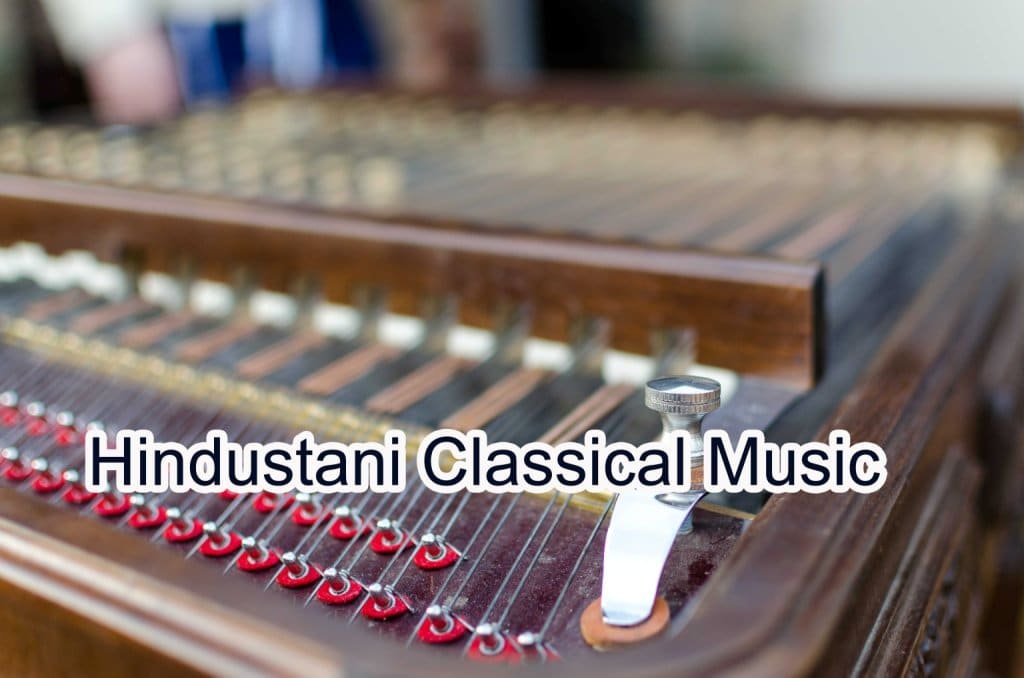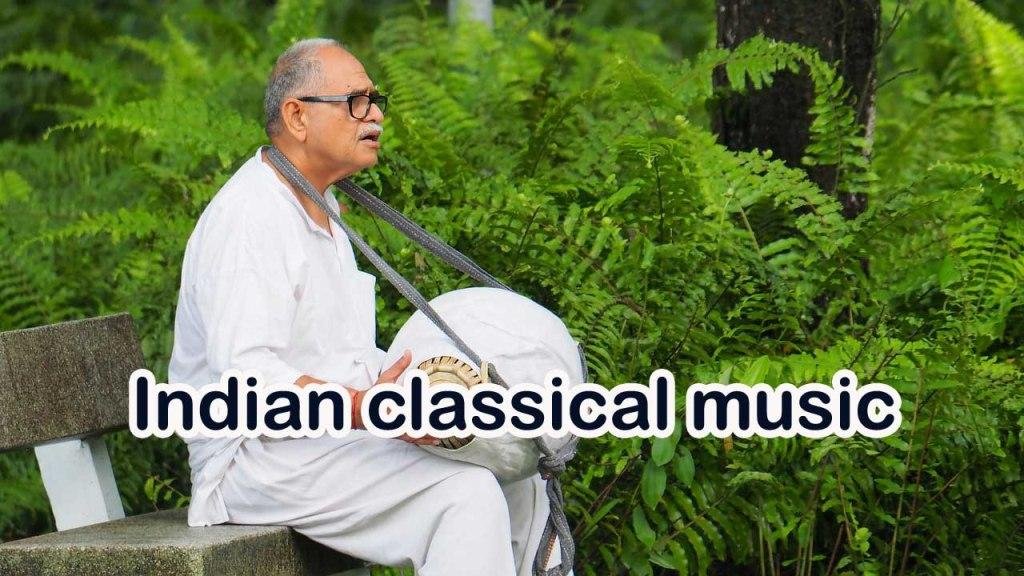Hindustani Classical Music belong to Northern India, Bangladesh and Pakistan’s. The sitar, sarod, tabla, and harmonium are the primary instruments used in Hindustani classical music. Ragas, which are melodic frameworks, and talas, which are rhythmic patterns, form the foundation of the music. It also comes in a variety of forms as Tarana, Dhrupad, Tappa, and Khyal. The music is often transmitted orally and historically taught to students in a guru-shishya (teacher-student) relationship.
Its foundations are found in regional folk music as well as ancient Vedic and Persian musical traditions. Major forms including dhrupad, khayal, and thumri are featured in this music, which is largely vocal in nature. Royal patronage supported the music in the past, but in current times, government-run radio stations, open performances, the film industry, and other kinds of media have all helped to keep the music alive.

Hindustani Classical Music
History of Hindustani Classical Music
Hindustani Classical music is a Vedic traditional form of music belonging to North India, Bangladesh and Pakistan. The Hindustani Classical music has its roots in ancient India, where music education was valued as a vital component of education. Hindustani Classical music was passed down through musicians and saints for generations and evolved into a complex art.
Hindustani classical music developed around the 12th century as a distinct style from Carnatic music. Both systems focus on the use of melodic modes or ragas and rhythmic cycles or talas. In medieval times, it was influenced by Persian music and later in the Mughal courts, notable composers like Tansen and religious groups like the Vaishnavites contributed to its development.
In the 16th century, singing styles diversified into different gharanas and around 1900, Vishnu Narayan Bhatkhande consolidated the musical structures of Hindustani classical music into a few thaats. Distinguished musicians are addressed as Pandit (Hindu) or Ustad (Muslim) and there is a tradition of religious neutrality in the music.
In 1901, Vishnu Digambar Paluskar founded the Gandharva Mahavidyalaya, a school to impart formal training in Hindustani classical music, which was open to all and one of the first in India to run on public support and donations, rather than royal patronage. This helped to bring respect to musicians and spread the music to the masses.
Sanskritic tradition
In Hindu mythology, characters such as Ravana and Narada are accomplished musicians and Saraswati, the goddess of music, is often depicted holding a veena. The Gandharvas, who are presented as musical spirits, and the gandharva style looks to music primarily for pleasure and the soma rasa. The Natya Shastra and Dattilam, both ancient Indian texts, discuss the concept of raga, which translates to “color” or “mood.”
The Dattilam also defines a tonal framework called grama and discusses different arrangements of notes and permutations and combinations of note-sequences. Music is also mentioned in texts from the Gupta period and Buddhist and Jain texts from the common era. Narada’s Sangita Makarandha treatise, which is the earliest text where rules similar to those of current Hindustani classical music can be found. In the 13th century, Sharangadeva composed the Sangita Ratnakara, which reveals an influx of ideas from Islamic culture and is often thought to date the divergence between the two classical music styles of Carnatic music and Hindustani music.
Hindustani music’s influence during the Delhi Sultanate
The arrival of Islamic rule under the Delhi Sultanate and later the Mughal Empire over northern India led to a cultural exchange and fusion of Hindu and Muslim ideas. Musicians received patronage in the courts of the new rulers, who in turn, became interested in local musical forms. One of the most influential musicians of this period was Amir Khusrau, who systematized some aspects of Hindustani music, introduced new ragas and instruments, and created six new genres of music. He is sometimes credited with the origins of the khyal form, but it is believed that the court musician Sadarang is the father of modern khyal.
The Bhakti tradition, which was strongly related to the Vaishnavite movement, remained influential and many composers wrote in the popular language of the people. During the Mughal Empire, music and dance flourished and Tansen introduced many innovations. After the dissolution of the Mughal Empire, the patronage of music continued in smaller princely kingdoms, leading to the diversity of styles known as gharanas. Many musician families obtained land grants, making them self-sufficient, and the Bhakti and Sufi traditions continued to interact with the different gharanas and groups.
Modern era
The Hindustani classical music tradition evolved over centuries and was passed on through the guru-shishya (“mentor-protégé”) system. This system had its advantages, but also its limitations, such as limited access to the music and the shishya often having to spend most of their time serving the guru. In the early 20th century, the decline of the patronage of the maharajahs and nawabs, and the emergence of Vishnu Digambar Paluskar and Vishnu Narayan Bhatkhande led to a shift in the way the music was disseminated.
Paluskar opened the Gandharva Mahavidyalaya music school and Bhatkhande produced a monumental four-volume work Hindustani Sangeeta Paddhati that suggested a transcription for Indian music, and described the many traditions in this notation. This helped in the standardization and popularization of the music. The government-run All India Radio and later corporate support helped to bring the artists to public attention and helped in making a living through public performances. In modern times, musicians like Ravi Shankar and Ali Akbar Khan have popularized Hindustani classical music around the world.
Characteristics
Indian classical music is characterized by a 12-note scale, with seven basic notes and five half-notes. The base frequency of the scale is not fixed and the intervals between notes can vary. The performance is based on a melodic pattern called a raga, which includes specific sequences of ascending and descending notes, key notes, and unique phrases. Ragas can come from various sources, including religious hymns, folk music and even non-Indian music. Examples of this include raga Khamaj which was adapted from folk music and raga Hijaz which originated from Persian maqams.
Principles of Hindustani music
Indian classical music is based on a 12-note scale, with seven basic notes and five interspersed half-notes. The base frequency of the scale is not fixed and the performance is set to a melodic pattern called a raga, which is characterized by specific ascent and descent sequences, “king” and “queen” notes, and characteristic phrases. These ragas can originate from various sources, including religious hymns, folk tunes, and music from outside the Indian subcontinent.
The Gandharva Veda, a Sanskrit scripture, describes the theory of music and its applications in not just musical form and systems but also in physics, medicine, and magic. The rhythmic organization of Indian classical music is based on rhythmic patterns called tala and the melodic foundations are called ragas. These ragas can be classified into “melodic modes” or “parent scales” called thaats. Thaats may consist of up to seven scale degrees or swaras. The Hindustani musicians name these pitches using a system called Sargam, which is the equivalent of the Western movable do solfege.
In Indian classical music, there are three primary registers: mandra (lower), madhya (middle), and taar (upper). A typical rendition of Hindustani raga involves two stages, the Alap and the Bandish or Gat. Hindustani classical music is primarily vocal-centric, as the musical forms were designed primarily for vocal performance, and many instruments were designed and evaluated based on how well they emulate the human voice.


